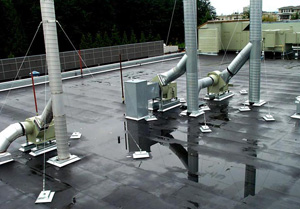Pitched versus Flat Roofing
November 17th, 2023
Roofs are arguably the most important feature of any building regardless of whether you are talking about commercial, industrial, or residential buildings. Roofs offer shelter and protection from inclement weather, but they are also one of the key structural components of a building. If you are building a home or other outdoor building and you are considering what type of roof to install, you will want to consider some of the pros and cons of pitched versus flat roofing. Pitched and flat roofing are popular choices for all types of buildings, but there are certainly advantages and disadvantages to each – let’s take a closer look.
Pitched Roofing
First, let’s talk a bit about pitched roofs. These roofs, as the name implies, feature some kind of slope or pitch. There are a variety of styles of pitched roofing including gable, cross gable, and hipped. These types of roofs are built with a pitch of some degree, and we typically associate these roofs with residential structures, though they are used for commercial and industrial buildings as well.
As with all roofing structures, regular maintenance of pitched roofing is crucial to maintaining the long-term integrity of the roof. With regular maintenance, your pitched roof can last two or more decades without major leaks posing a problem. However, because of the angled nature of the roof structures, pitched roofs are more difficult to inspect and maintain. On the other hand, water and melting snow and ice more readily clears off the roof so damage related to standing water is less of a concern.
Pitched roofs are usually more expensive to install, but despite the challenges associated with maintenance and repair they tend to cost less to repair in the long run. This is most often attributed to better drainage than flat roofs as poor drainage is associated with damage from moisture.
Flat Roofing
Alternatively, flat roofing systems have no pitch, or a very slight slope to encourage adequate run-off for water or melting snow and ice. These are usually categorized as built-up, single-ply, or sprayed polyurethane foam designs.
Like pitched roofs, flat roofing requires regular maintenance. As suggested, maintaining a flat roof is somewhat easier because of the flat surface of the roof. However, with poorer drainage associated with flat roofs, drains are more easily blocked and damage and leaks can be more common than with pitched roofs. Still, regular inspections and maintenance of flat roofs help to mitigate these risks.
Another benefit of flat roofing is it tends to be cheaper than pitched or sloped roofing. Nevertheless, in climates with a lot of precipitation, flat roofs tend to require more maintenance and the savings associated with installation may be lost in maintenance and repair costs over the years.
Ultimately, there are many reasons to choose either pitched or flat roofs for your home or building. Speak to a qualified contractor for help making the best decision for your project.




